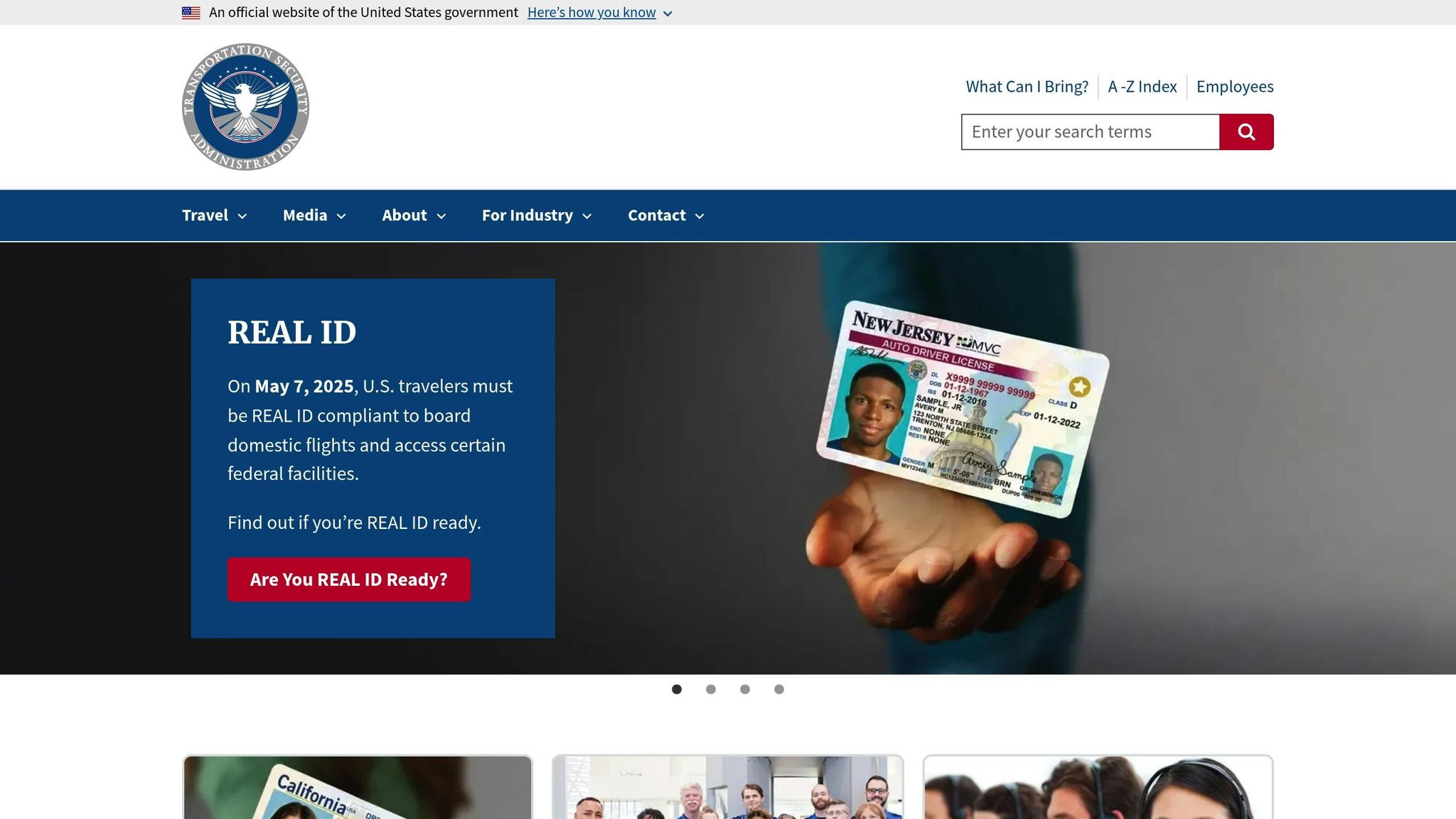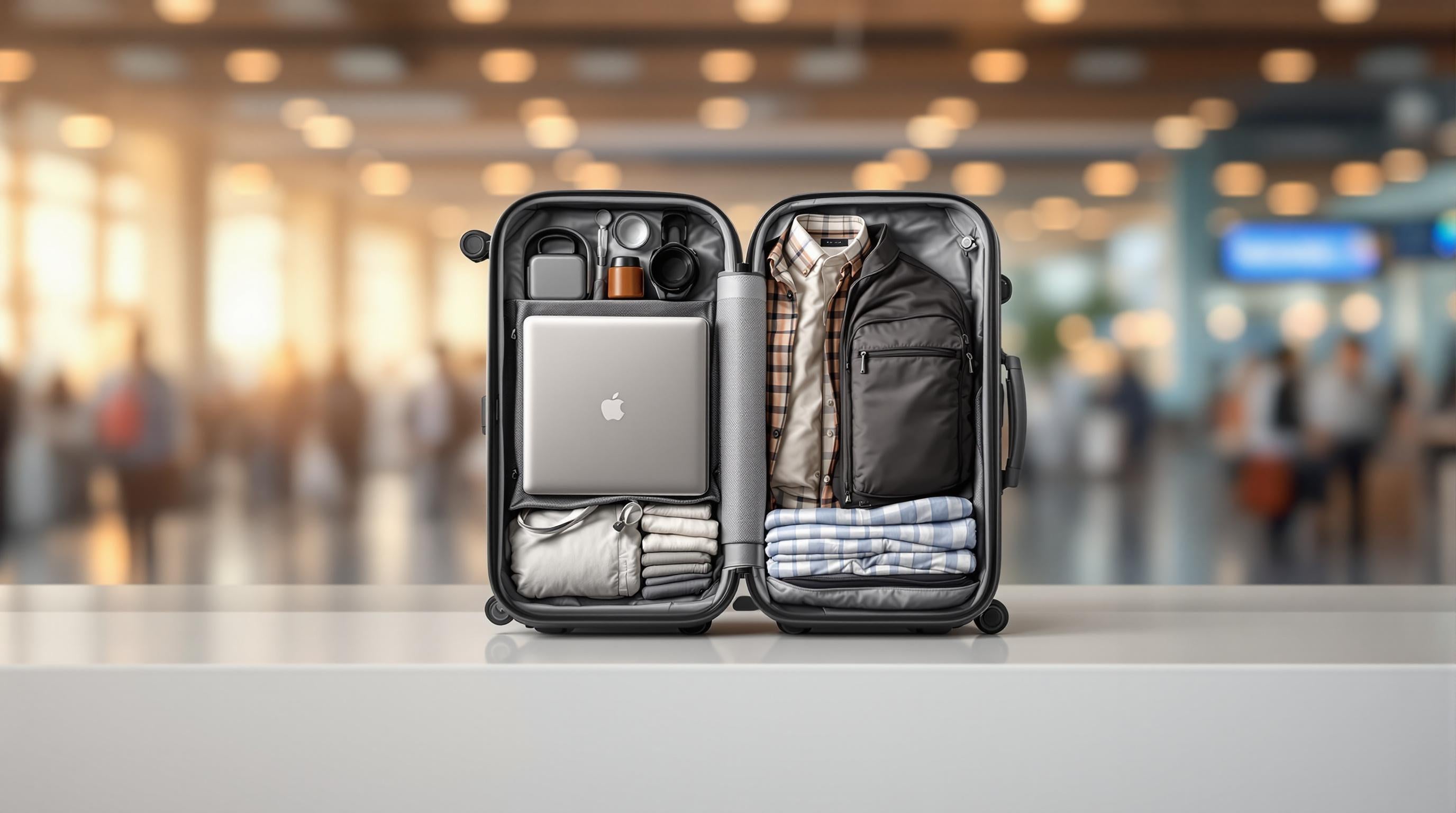- Choose the right bag: Look for carry-ons that fit airline size limits (22 x 14 x 9 inches for most U.S. airlines) and include space-saving features like vacuum compression.
- Pack smart: Use rolling techniques, compression cubes, and layer items efficiently.
- Check airline rules: Know size, weight limits, and fees for oversized or overweight bags.
- Prepare for TSA: Keep electronics and liquids easily accessible for faster security checks.
Top Tip: Bags like the Titantrek Atlas Vault Backpack with built-in vacuum compression help you pack more while staying within size limits. Just remember to double-check measurements for stricter airlines like Ryanair to avoid last-minute fees.
Follow these steps to pack efficiently, avoid penalties, and breeze through your next trip.
Avoid Extra Fees: 9 Easy Carry-On Packing Tips You Need to ...
Airline Carry-On Rules
Knowing airline carry-on rules can save you from unexpected fees.
Size and Weight Limits
Most U.S. airlines allow carry-on bags measuring up to 22 x 14 x 9 inches, with a total dimension limit of 45 inches. Weight rules differ by airline - some only require you to lift the bag into the overhead bin, while others have stricter weight limits.
Penalty Fees
Oversized or overweight bags can lead to hefty fees, especially if they need to be gate-checked at the last minute. These charges are usually higher at the gate.
To maximize space while staying within size limits, consider bags with built-in compression features. For example, vacuum compression systems can shrink bulky items, making packing easier. Brands like Titantrek offer travel backpacks with advanced compression technology (https://titantrekstore.com).
Here are a few tips to prepare your bag before heading to the airport:
- Measure your packed bag to ensure it meets size requirements.
- Weigh your bag using a portable luggage scale.
- Review your airline’s latest rules online.
- Leave extra room for items you might buy during layovers.
Keep in mind that size measurements include wheels, handles, and external pockets - everything must fit within the airline's stated dimensions when checked at the gate.
Selecting Travel Bags
Picking the right travel bag can help you avoid extra fees and make packing more efficient. The goal? A bag that offers plenty of space while meeting airline size limits. Below, we break down some great options.
Compression Backpacks
Compression backpacks are perfect for maximizing carry-on space. These bags use a built-in vacuum compression system to shrink the bulk of your belongings. A great example is the Titantrek Atlas Vault Backpack.
Features to look for:
- Built-in vacuum compression
- TSA-approved locks for added security
- Waterproof materials to protect your items
- Laptop compartment (fits devices up to 17 inches)
- Anti-theft pockets for valuables
- Comfortable, ergonomic design
Traveler Darcey Ritchie shared her experience in January 2025: "Perfect travel suitcase for the price! A lot of quality and a lot of compartments! I loved it! I recommend it to everyone!"
Packing Organizers
Packing organizers are a smart addition to your travel gear. These tools help you make the most of your bag's space while keeping everything neat and easy to find.
| Organizer Type | Purpose | Benefits |
|---|---|---|
| Compression Cubes | Clothes storage | Reduces the size of your clothing |
| Tech Pouches | Electronics organization | Keeps cables and devices tidy |
| Toiletry Kits | Bathroom essentials | Keeps toiletries in one place |
When choosing packing organizers, make sure they fit your bag's dimensions. For example, if your carry-on measures 22 x 14 x 9 inches, select organizers that stack well within those limits.
sbb-itb-b1567d8
What to Pack
Plan your packing carefully to avoid extra fees and make your trip stress-free. Here's how to get started:
Clothes and Shoes
| Clothing Category | Essentials | Tips for Packing |
|---|---|---|
| Base Layers | 3-4 t-shirts, 2-3 pairs of underwear | Opt for wrinkle-free fabrics |
| Bottoms | 2 pairs of pants or shorts | Stick to neutral colors for versatility |
| Outerwear | 1 lightweight jacket or sweater | Wear your bulkiest item to save space |
| Footwear | 1-2 pairs max | Stuff socks inside shoes to save room |
For shoes, bring one pair of comfortable walking shoes and, if needed, one dressier option. Wear the bulkier pair while traveling to free up space in your bag. This approach helps you meet airline size and weight restrictions.
TSA-Approved Toiletries

Stick to the TSA's 3-1-1 rule for liquids: 3.4 oz max per container, 1 quart-sized clear bag, 1 bag per passenger.
- Travel-sized shampoo and conditioner
- Toothpaste and toothbrush
- Solid deodorant (preferred over liquid)
- Face moisturizer
- Hand sanitizer
Tip: Transfer your go-to products into reusable TSA-approved containers. This saves money and ensures a hassle-free security check.
Electronics
| Item | Purpose | Packing Advice |
|---|---|---|
| Laptop/Tablet | Work or entertainment | Use a dedicated laptop sleeve |
| Chargers | Keep devices powered | Store in a tech pouch |
| Power Bank | Backup charging | Keep in carry-on luggage |
| Universal Adapter | For international travel | Pack with other electronics |
Organize your cables and chargers in a tech pouch to keep them tangle-free. This setup also speeds up security checks and protects your devices.
Travel Documents
Once your gadgets are sorted, focus on your travel documents. Keep these items easy to access:
- Primary Documents: Passport, government-issued ID, boarding pass
- Secondary Documents: Travel insurance info, hotel confirmations
- Payment Options: Credit cards and a small amount of cash
Store everything in a waterproof pouch or a separate compartment in your bag. It's also a good idea to create digital backups of important documents.
Quick Tip: Use an easily accessible pocket in your carry-on for these items. This makes check-in and security screenings much faster.
Space-Saving Packing Methods
Once you've picked the right bag, smart packing techniques are the next step to ensure you stay within airline limits while making the most of your carry-on space. These tips can help you pack efficiently without sacrificing what you need.
Clothes Rolling Guide
Rolling your clothes the right way can save space and keep your items organized. Here’s how to roll different types of garments:
| Garment Type | Rolling Method | Benefits |
|---|---|---|
| T-shirts & Tops | Roll tightly into a cylinder | Reduces wrinkles and creates compact rolls |
| Pants & Jeans | Fold lengthwise, then roll tightly | Keeps creases intact and saves space |
| Dresses & Skirts | Roll from hem to waist | Minimizes wrinkles and uses vertical space |
| Underwear & Socks | Roll into small bundles | Keeps items organized and compact |
Tip: For delicate items like dress shirts, place a sheet of tissue paper between folds before rolling to reduce wrinkles.
Bag Loading Order
Packing in layers can help you maximize space and keep your items accessible. Here’s a simple order to follow:
- Bottom Layer: Place heavier items like shoes and toiletry bags here.
- Middle Layer: Add your rolled clothing bundles.
- Top Layer: Use this space for lightweight items and anything you may need during the flight.
- External Pockets: Store travel documents and electronics for quick access.
To save even more room, pack shoes heel-to-toe at the bottom of your bag and stuff them with socks or other small items.
Using Compression Features
The Titantrek Atlas Vault’s built-in vacuum compression system is a great way to maximize your packing space while staying within airline size limits. Many users praise its vacuum pump for being highly effective [1].
For best results: Group similar items, compress gradually with steady pressure, and double-check that your bag meets airline size rules. Keep in mind that some budget airlines have stricter size requirements, even for compressed bags. Always confirm before you fly!
Pre-Flight Bag Check
Before you head to the airport, double-check your carry-on to make sure it’s organized for a smooth TSA screening. This step also helps you stay within the airline's size and weight limits.
Getting Through Security Faster
Set up your carry-on to make TSA checks easier: keep electronics in a spot where they’re easy to grab, place your 3-1-1 liquid bag somewhere accessible, and group items logically. A little prep can save time and help you move through security without hassle.
Conclusion
Following the tips outlined above, sticking to airline carry-on rules becomes much easier with the right tools and approach. A vacuum compression backpack, like the Titantrek Atlas Vault Backpack, can help you fit more into your bag while staying within most size limits. However, when fully packed, it might not meet the stricter requirements of some budget airlines.
Customer feedback highlights the importance of careful packing. As Titantrek customer Thao Dach shared:
"Very sturdy and well made backpack! The vacuum pump does its work. Everything is fine except that it does not respect Ryanair's measurements. Until they check it's fine, if it's full of zeppo, it's too big." [1]
This serves as a reminder to double-check your bag's dimensions before heading to the airport.
Using smart packing techniques and compression tools can help you avoid oversized baggage fees while keeping your items secure. Features like TSA-approved locks and anti-theft pockets provide added peace of mind.
To pack successfully, focus on three key steps: picking the right bag, maximizing space efficiently, and checking your bag's size before your flight. By following this guide, you'll breeze through airport security and avoid extra carry-on charges.

How to Avoid Oversized Carry-On Fees on Budget Airlines
How Vacuum Compression Protects Gear from Humidity